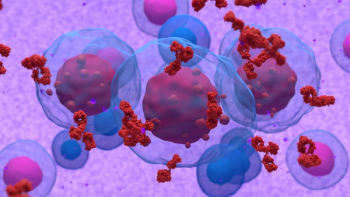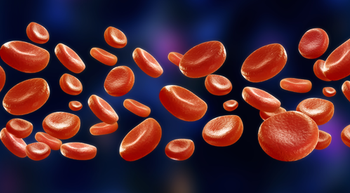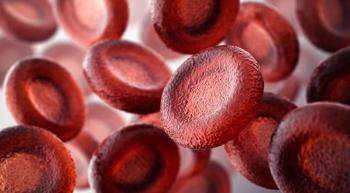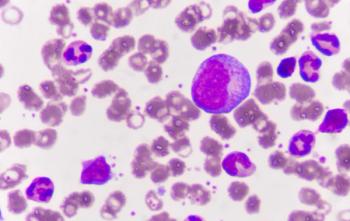
- Rx Road Map: Subcutaneous Daratumumab in Multiple Myeloma
Rx Road Map: Subcutaneous Daratumumab in Multiple Myeloma
A registered nurse gives best practices for use of subcutaneous daratumumab in multiple myeloma.
Who Is This Drug Approved For?
The FDA approved the use of daratumumab and hyaluronidase-fihj (Darzalex Faspro) for patients who are newly diagnosed with multiple myeloma and are eligible for autologous stem cell transplant. In this patient population, daratumumab and hyaluronidase-fihj is given with bortezomib (Velcade), lenalidomide (Revlimid), and dexamethasone; this regimen is known as D-VRd and will be used as induction as well as consolidation leading toward the transplant.1
What Efficacy Data Back It Up?
The FDA approval is supported by data from the PERSEUS study (NCT03710603), which involved 709 patients who were randomly assigned to receive either the standard VRd regimen (bortezomib, lenalidomide, dexamethasone) or the daratumumab-enhanced regimen (D-VRd).2 The new, enhanced regimen of D-VRd achieved a 60% reduction in disease progression or death compared with the standard VRd.1 It also resulted in a deeper response at the end of consolidation, which could significantly delay disease progression. This latest quadruple therapy, D-VRd, is given as a first line of treatment when patients are likely to experience deeper responses, offering hope for patients with multiple myeloma who are transplant eligible.
How It Works
Daratumumab (Darzalex) is a human immunoglobulin G1 k (IgG1k) monoclonal antibody designed to bind to CD38 proteins in multiple myeloma cells and activate immune cells, such as natural killer cells and macrophages, to attack and destroy myeloma cells. It essentially directly kills myeloma cells and/or enables the immune system to recognize and terminate them. Hyaluronidase is an enzyme that helps antibody IgG1k reach the target, protein CD38. When the medication is administered, this enzyme breaks down the subcutaneous tissue surrounding the injection site. Permeability of the tissue is restored within 24 to 48 hours.
How It’s Administered and the Recommended Dose
This treatment requires the following premedications: oral acetaminophen (Tylenol), diphenhydramine plus phenylephrine (Benadryl), and intravenous or oral corticosteroids.3 The prescribing physician will determine the dose and route of the premedications, along with the wait time (usually between 1 and 3 hours).
Daratumumab and hyaluronidase-fihj is a subcutaneous injection given in the abdomen. Nurses should choose a site approximately 3 in (7.5 cm) to the right or left of the patient’s navel. The standard dose for every patient is 1800 mg of daratumumab and 30,000 units of hyaluronidase per 15 mL. The entire 15 mL is given by a slow push over 3 to 5 minutes.
How to Manage Associated Adverse Events
- Hypersensitivities: These can be observed, especially after the first and second dose. Please follow your facility’s protocol for systemic allergic reactions (severe or life-threatening) and consider symptomatic management for local reactions (erythema, itching).
- Neutropenia and thrombocytopenia: Monitor the patient’s complete blood cell count with differential and consider withholding the treatment until the count recovers.
- Embryo-fetal toxicity: Female patients with reproductive potential should use effective contraception both while on treatment with daratumumab and hyaluronidase-fihj and for 3 months following treatment.
- Interference with serological testing: Treatment with daratumumab and hyaluronidase-fihj could interfere with red blood cell antibody screening or cross-matching, so patients should be typed and screened before initiating therapy. Additionally, blood banks should be told whether a patient has received daratumumab and hyaluronidase-fihj. These serological changes can be seen up to 6 months after treatment.4
What to Inform Patients About to Start Treatment
The most common adverse effects reported include nausea, fatigue, upper respiratory infections, and constipation. Coldlike symptoms and fatigue are very common, but any fever of 100.4 °F (38 °C) or higher should be reported to the provider.
Teach your patients about pancytopenia. The patient will be taking an oral corticosteroid for up to 2 days post treatment to reduce the risk of delayed reactions. Reaction times typically range from 4 minutes to 3.5 days. Please inform the patient when to seek medical attention. Some patients may need antiviral medications to prevent herpes zoster reactivation. Hepatitis B reactivation can also occur; please check the patient’s medical history or obtain a hepatitis B panel.
Advice for Nurses Who Administer This Agent
The injection will take 3 to 5 minutes—to protect your back, sitting down is strongly encouraged.
For successive injections, injection sites should be rotated. Avoid injecting into red, hard, bruised, scarred, or tender skin. The rate of injection should be slowed if a patient is in pain. Daratumumab and hyaluronidase-fihj should not be given alongside other subcutaneous treatments.
How to Safely Handle This Drug
Use recommended personal protective equipment while administering the drug.
References
- Darzalex Faspro (daratumumab and hyaluronidase-fihj)-based quadruplet regimen approved in the U.S. for patients with newly diagnosed multiple myeloma who are transplant-eligible. Johnson & Johnson. July 30, 2024. Accessed April 30, 2025. https://www.jnj.com/media-center/press-releases/darzalex-faspro-daratumumab-and-hyaluronidase-fihj-based-quadruplet-regimen-approved-in-the-u-s-for-patients-with-newly-diagnosed-multiple-myeloma-who-are-transplant-eligible
- Sonneveld P, Dimopoulos MA, Boccadoro M, et al. Daratumumab, bortezomib, lenalidomide, and dexamethasone for multiple myeloma. N Engl J Med. 2024;390(4):301-313. doi:10.1056/NEJMoa2312054
- Darzalex Faspro. Prescribing information. Janssen Biotech Inc; 2024. Accessed April 30, 2025. https://www.janssenlabels.com/package-insert/product-monograph/prescribing-information/DARZALEX+Faspro-pi.pdf
- Darzalex Faspro patient tips. Drugs.com. Updated August 7, 2024. Accessed April 30, 2025. https://www.drugs.com/tips/darzalex-faspro-patient-tips
Articles in this issue
Newsletter
Knowledge is power. Don’t miss the most recent breakthroughs in cancer care.

















































































